Submitted by WA Contents
A Pioneering New Institute And Genocide Memorial in Cambodia Designed by ZHA
United Kingdom Architecture News - Oct 14, 2014 - 16:57 8020 views
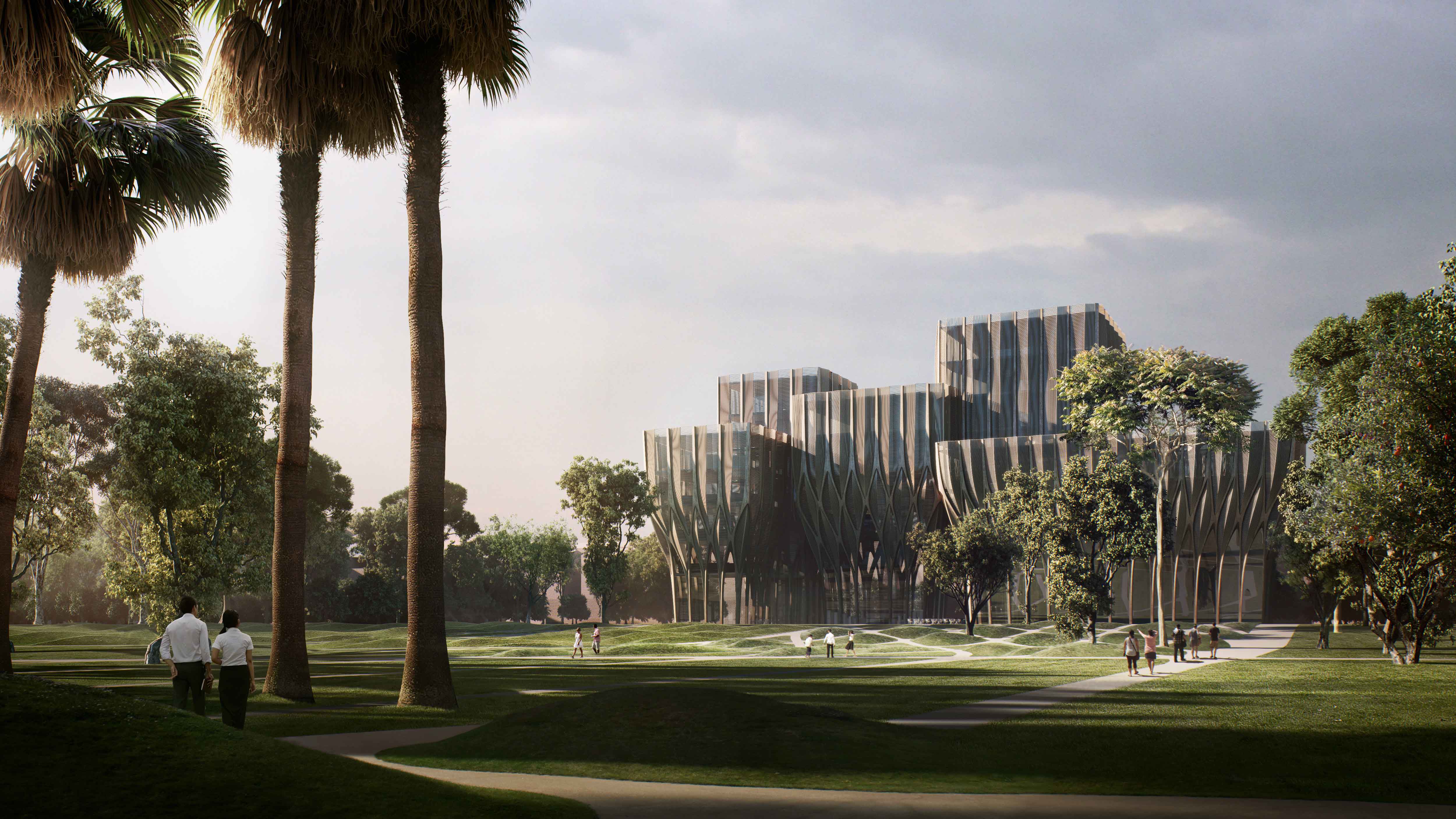
image courtesy of Zaha Hadid Architects
Designs for the Sleuk Rith Institute – a new institution and genocide memorial in the Cambodian capital Phnom Penh - have been unveiled. The institute brings together a museum, research centre, graduate school, document archives and research library.
The vision of Youk Chhang, a tireless human rights activist and investigator of the Khmer Rouge atrocities, the Sleuk Rith Institute was founded by Chhang as a focus for reflection, healing and reconciliation as well as an enlightening educational and research facility dedicated to commemorating the lives of the past by building a better future.
During the 1970s Youk Chhang, at the age of 15, was a prisoner under the Khmer Rouge and members of his family were victims of the regime. Through his Documentation Centre of Cambodia, he has spent more than a decade amassing details of atrocities committed by the former Cambodian regime, The Democratic Kampuchea (DK), which is also known as the Khmer Rouge.
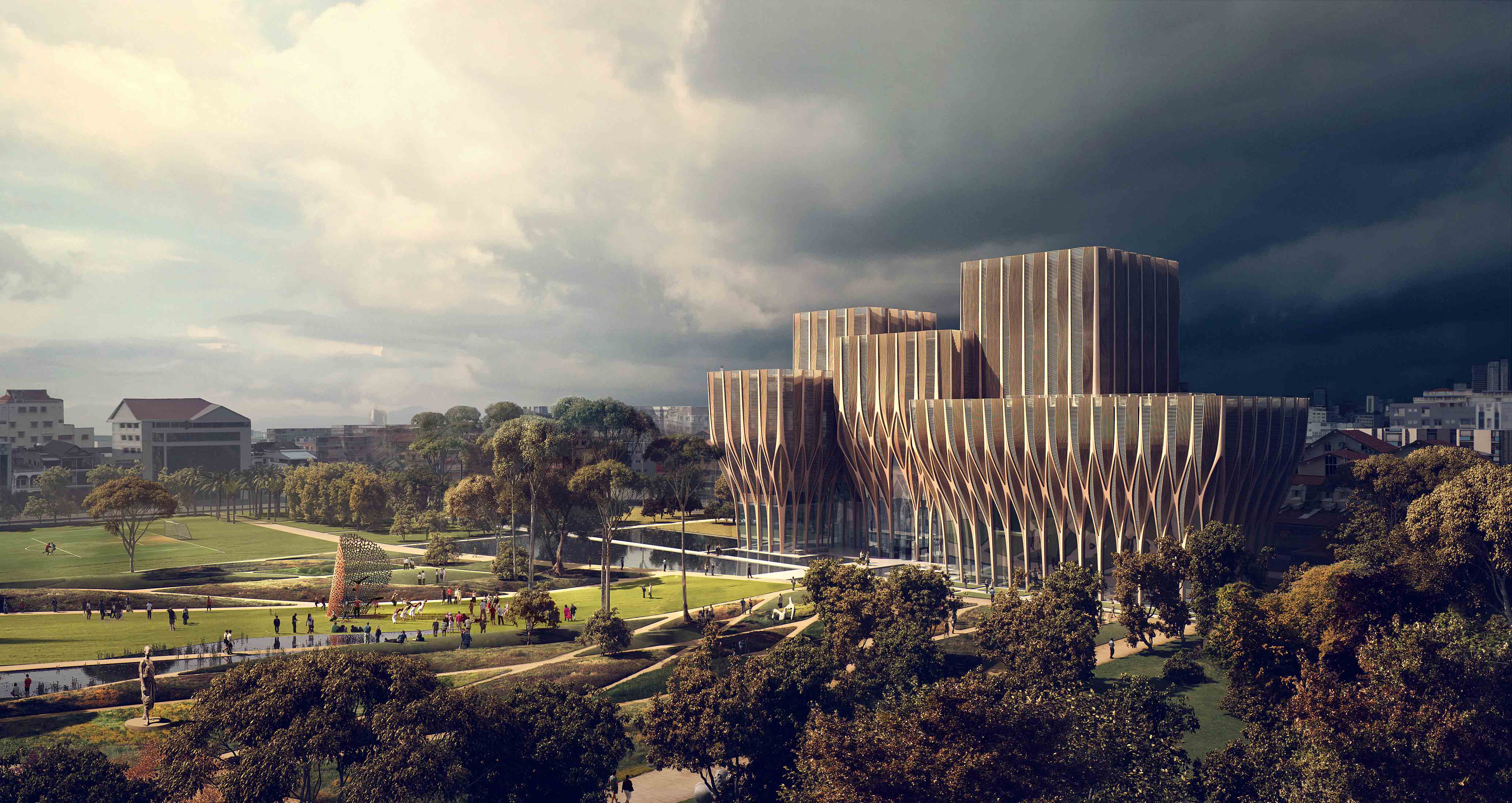
image courtesy of Zaha Hadid Architects
The Sleuk Rith Institute is designed by Zaha Hadid Architects and will house the Documentation Centre of Cambodia’s one million documents in its archives and, as the largest collection of genocide related material in Southeast Asia, will become a global centre for education and research into the documentation, causes and prevention of genocide.
Despite the tragic history explored at the institute, Youk Chhang’s research led to the very considered brief for a building that promoted reflection and reconciliation, and also inspired and innovated. “Cambodia will never escape its history, but it does not need to be enslaved by it. Post-conflict societies have to move on,” he says.
This brief required a direction that breaks from some of the stereotypes associated with genocide memorial architecture. “In the context of genocide and mass atrocity, memorial architecture has tended to reflect the evil and misfortune of the historical period it represents,” he says. “In this sense, the architecture’s legacy is dark, sombre, and firmly oriented to the past.”
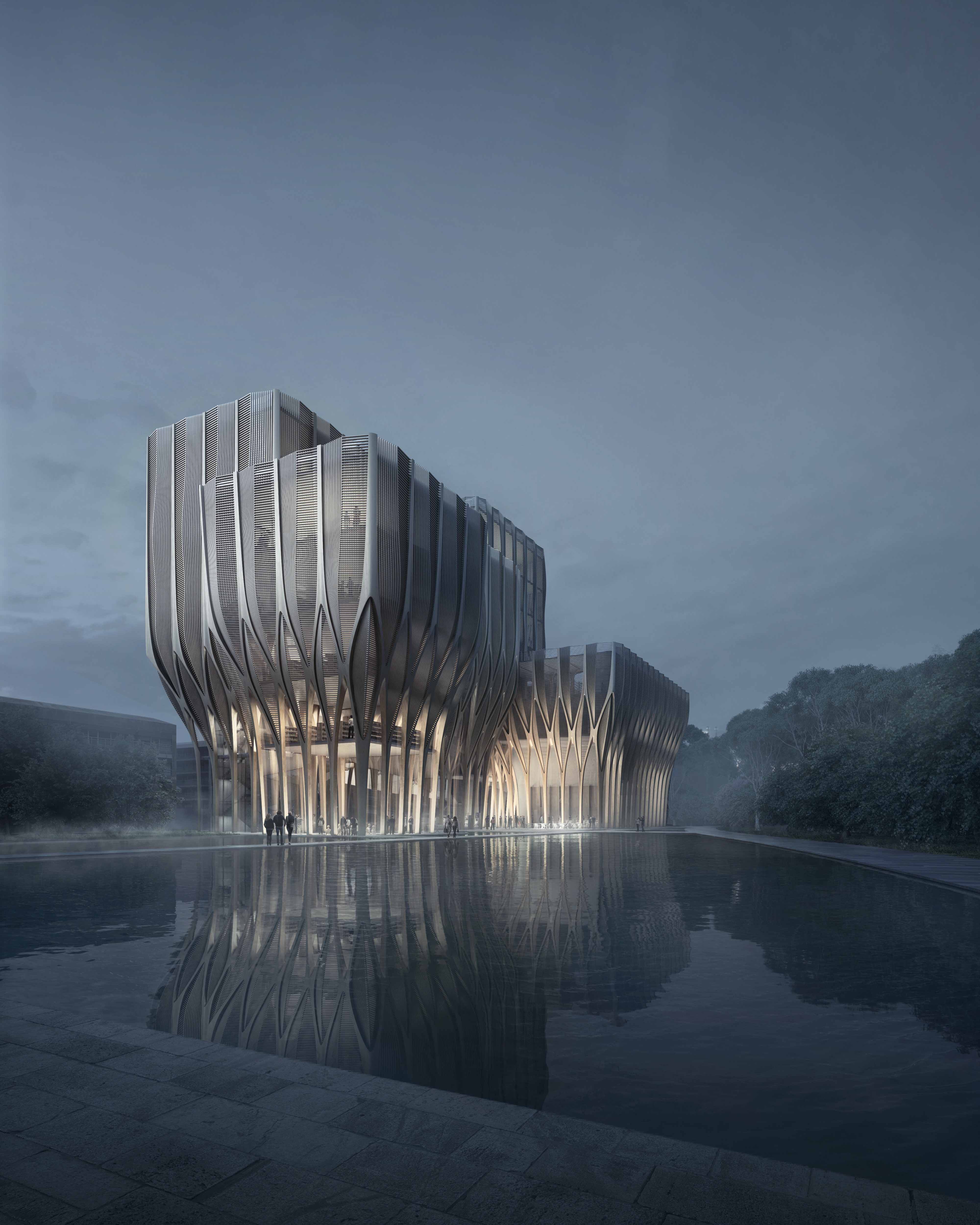
image courtesy of Zaha Hadid Architects
“We were keen to create a forward-looking institution that deviates from the distress-invoking, quasi-industrial, harshness of most existing genocide memorial models. This is not to criticize or denigrate such models but, instead, to emphasize that in light of a Cambodia’s rich cultural and religious traditions, we must move in a different and more positively-oriented direction.”
“The best memorials are not objects we visit once, contemplate, and file away. The best memorials evoke reflection and commemoration, but are also living, dynamic public places that engage with all generations in the community,” continues Chhang.
The Sleuk Rith Institute will not focus only on the past, but rather seek to create an institute that will also be enlightening; a place for new generations to learn from the lessons of the tragedies of the past while exploring ways to heal, and move forward. “It is this commitment, determination and belief in our future that will define us,” explains Chhang.
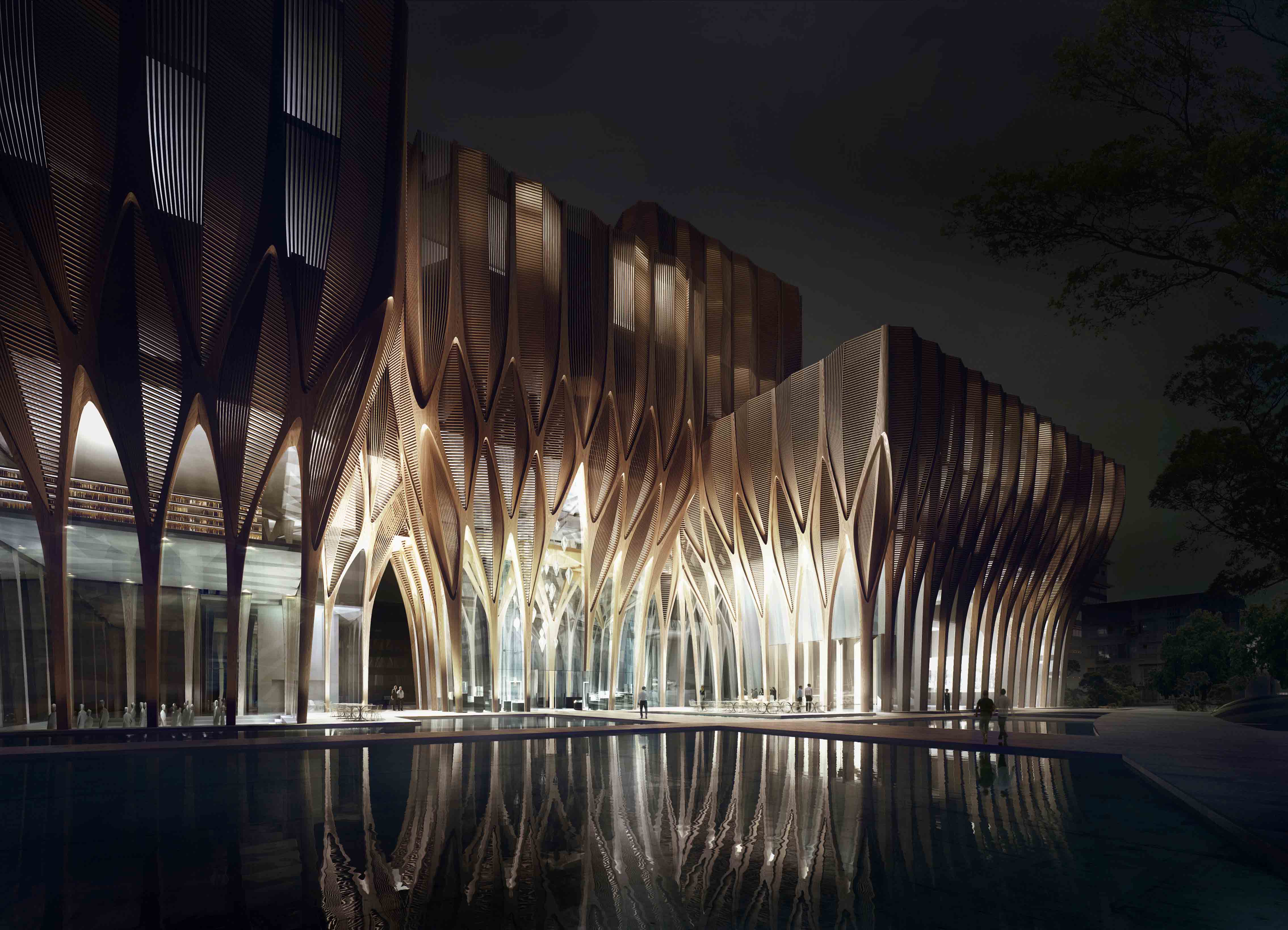
image courtesy of Zaha Hadid Architects
The Sleuk Rith Institute will combine a strong educational and outreach program together with its ongoing work for social justice as well as the commemorative nature of a memorial museum.
The institute’s design is organized as five wooden structures that are separate volumes at ground level, but interweave and link together as they rise upwards; connecting the different departments, visitors, students and staff within a singular whole. With an overall footprint of 80m x 30m at the base and 88m x 38m at roof level, the structures range between three to eight storeys.
Each of these five buildings will house a different function: the Sleuk Rith Institute; a library holding the largest collection of genocide-related material in Southeast Asia; a graduate school focussing on genocide, conflicts and human rights studies; a research centre and archive to influence national and regional policies and discourse; a media centre and an auditorium that can be used by the institute and the entire community.
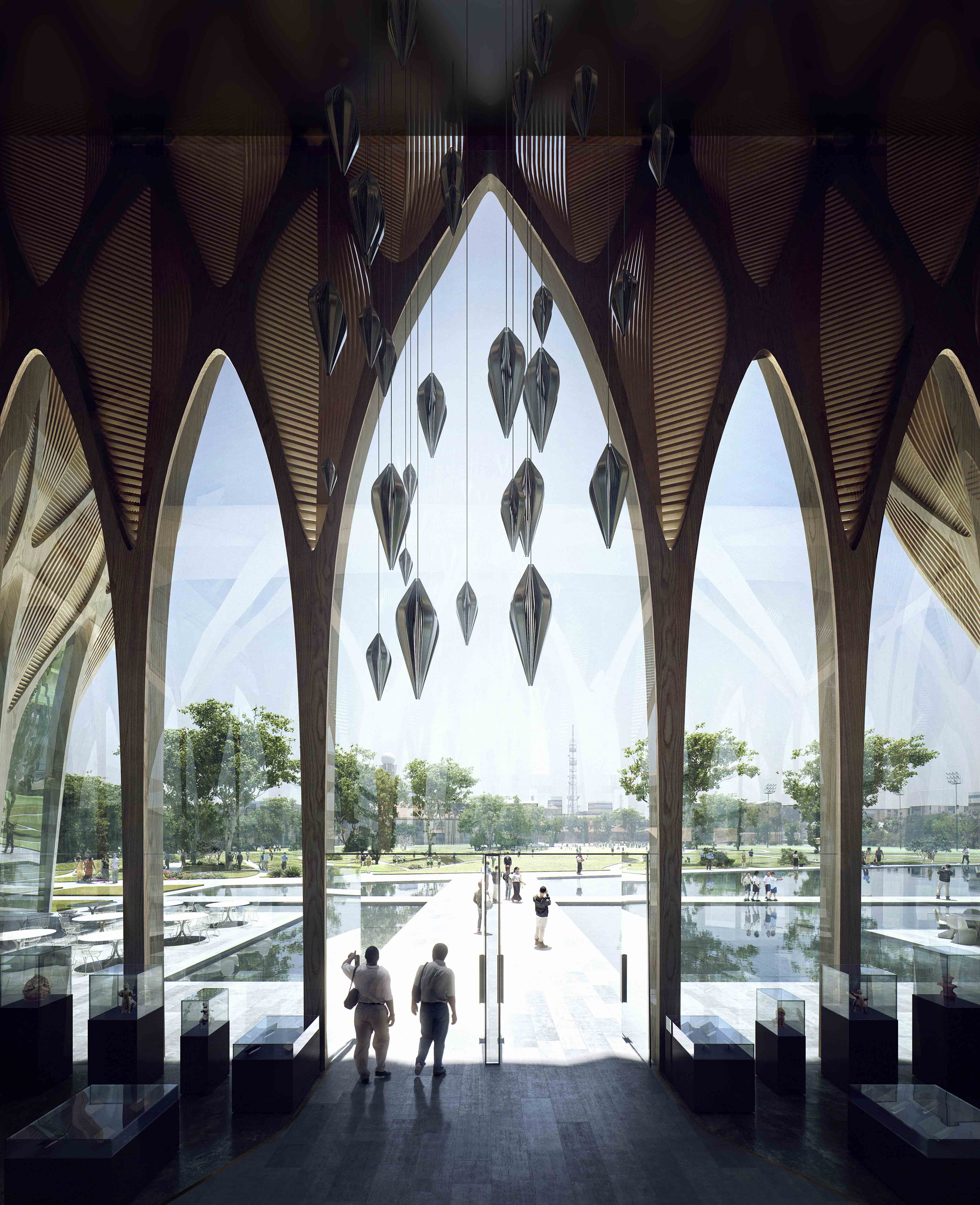
image courtesy of Zaha Hadid Architects
The architecture of the ancient temple site Angkor Wat, and Cambodia’s many other remarkable Angkorian sites, builds complexity by combining and interlocking a multitude of geometric forms in a formal progression of connected enclosures.
As they gain in height and coalesce, the Sleuk Rith Institute’s five buildings define an intricate spatial composition of connecting volumes; generating a series of exterior and interior spaces that flow into each other to guide visitors through the different areas for contemplation, education, engagement and discussion.
The design connects the museum, library, school and institute at various levels, allowing different users to interact and collaborate, enhancing their understanding and experience. Yet each of the institute’s functions is also able to operate independently when required.
Constructed from sustainably-sourced timber, the primary structure, exterior shading and interior partitions give natural scale, warmth and materiality. The more complex forms have been designed and engineered to be assembled from economical straight and single-curved timber sections with established technologies.
The site is located in the grounds of the Boeung Trabek High School in Phnom Penh, south of the city centre. The existing school buildings (now abandoned when the high school moved to its new premises) were used as a re-education camp during the Khmer Rouge regime – as were many schools in Cambodia - making this a fitting location for the Institute: building on the past to educate the future.

image courtesy of Zaha Hadid Architects
To accommodate Cambodia’s tropical climate, the narrower lower levels of the institute are shaded by the building’s form, while louvers on the upper levels keep out strong sunshine. Located at the confluence of the Mekong and Tonlé Sap Rivers, the institute’s buildings will be built on raised terraces, to protect from Phnom Penh’s seasonal flooding.
Visitors approach the building on causeways above reflecting catchment pools that mirror the building’s form and bring light deep into the internal spaces. As with the catchment pools of Cambodia’s ancient temple sites including Sras Srang and Angkor Wat, these pools - and those on the upper level courtyard and terraces – will be fed by harvested rainwater and are integral to the institute’s water management processes that minimize the impact on the local environment and drainage systems.
Entering through the atrium at the centre of the building, visitors are welcomed by exhibits from the Institute’s collection. From here visitors are directed to the museum where exhibitions continue or to the school and auditorium. The auditorium is on ground level while classrooms and professors’ offices are organized around the outdoor courtyard above and continue on upper floors.
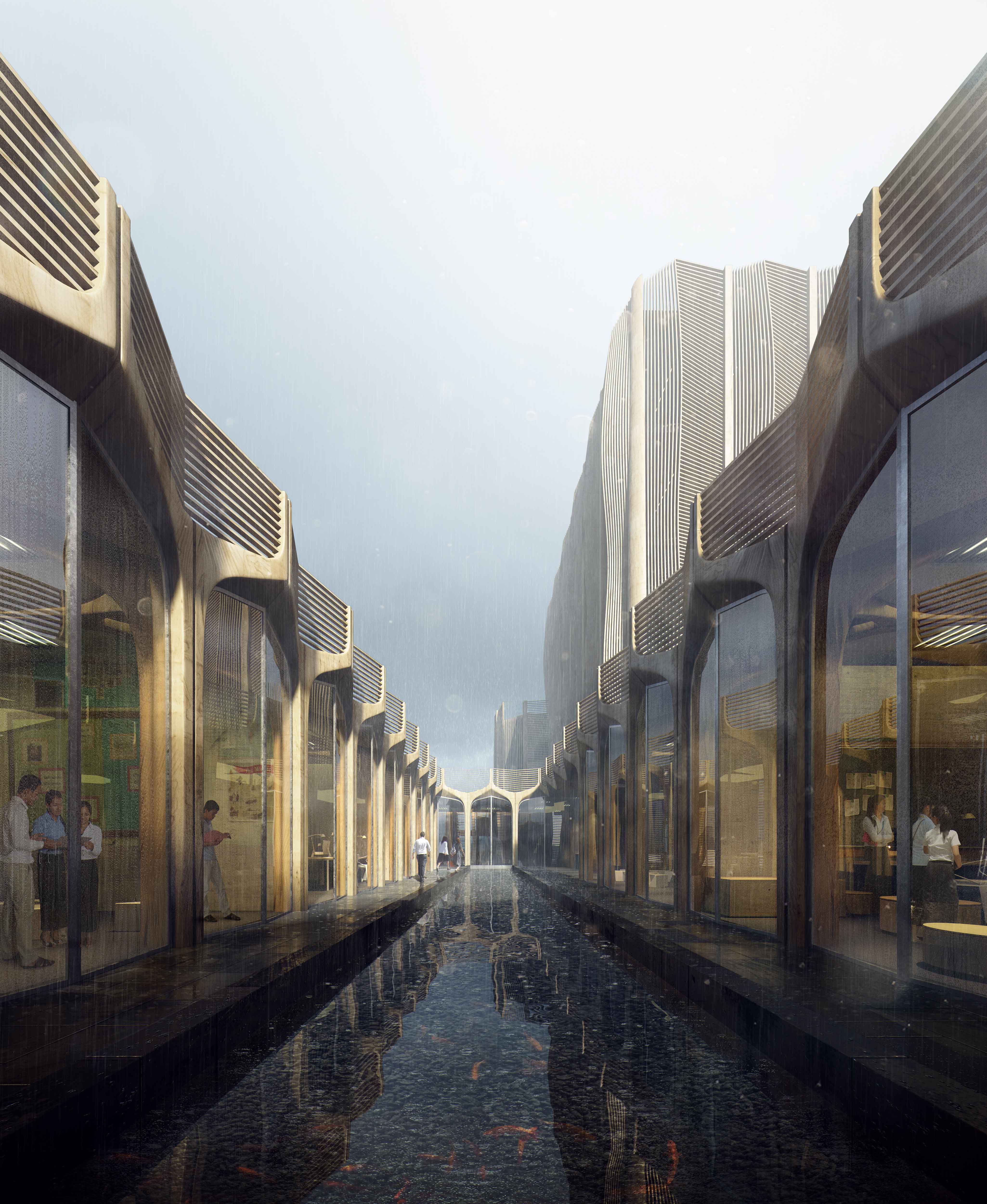
image courtesy of Zaha Hadid Architects
Above the entry atrium, the Institute houses the Documentation Centre archive, with offices for researchers and Institute administration on the top levels. A bridge is suspended above the atrium to connect the school and library.
The building’s passive design - including measures to reduce energy and water consumption while increasing system efficiencies, and the installation of renewable energy sources - will increase its ecological performance.
The institute’s form minimises solar gain, and the external shading system will be varied on each elevation to reduce solar gain whilst maintaining sufficient daylight levels where required. Thermal buffer zones protect the archive and exhibition spaces and further reduce energy consumption.
Water condensation from the air handling will be recovered for reuse and foul water will be treated on-site via bio-reactors or a natural plant-based wastewater treatment system that can be incorporated within the park.
The horizontal roof of the building is hidden from view to house renewable energy sources that are extremely effective in Phnom Penh’s climate: photovoltaic cells for power and a solar thermal array for hot water generation. Plant and air-system heat exchangers will also be located on the roof, maximizing the area within the building for the institute’s commemorative, educational, cultural and community programs.
The institute includes a 68,000 sq.m. memorial park for the entire community with sport fields, urban vegetable garden and fruit orchards, traditional meadows and a forest that will house contemporary Cambodian sculptures, many of these commemorating the women that helped to rebuild the country. The park slopes away from the building to provide further protection against seasonal flooding. The southern end of the park is landscaped to become a large retention pond during heavy monsoon rains, alleviating the city’s existing flood drainage. The park’s many pedestrian paths link together neighboring streets that had previously been disconnected, inviting the local community into the heart of the institute.
“Our hope is that the Sleuk Rith Institute and its Memorial Park can have a truly transformative effect, bringing new life and a bright future to a site that holds traces of the great tragedies of the past. An inviting place where reflection, interaction and connectivity are not only its spatial expression, but also embedded within its covenant to the people of Cambodia,” says Hadid.
The Sleuk Rith Institute complex has been granted approval and is scheduled to start construction on site next year.
For further information about the Sleuk Rith Institute please visit www.cambodiasri.org
Project Facts
Client
Sleuk Rith Institute
Youk Chhang (Founder & Executive Director,
Documentation Centre of Cambodia)
Architect
Zaha Hadid Architects (ZHA)
Design: Zaha Hadid and Patrik Schumacher
ZHA Design Director: DaeWha Kang
ZHA Lead Designer/ Project Leader: Brian Dale
ZHA Project Team: Malgorzata Kowalczyk
Michal Wojtkiewicz, Torsten Broeder, Fernanda Mugnaini
Cunsultants
Arup (Structure/MEP/Façade/Lighting/Acoustics)
Project Director: Chris Carroll
Project Manager / Structure Lead Ben Lewis
MEP Lead: Emmanuelle Danisi
Facade Lead: Jonathan Wilson
Lighting: Giulio Antonutto
Acoustics: Philip Wright
Project Team: Vincenzo Reale, Jason Simpson, Edward Clarke
Anne Gilpin, Toby Clark, Sara Clark, Michael Young
AECOM (Landscaping)
Design Director: Phil Black
Project Manager: Mun Pheng Mak
Associate: Sarmistha Mandal
Design Team: Hwei Hwei Chan, Akarapol Chongwattanaroj,
Eunice Chia, Chung Ho Kim
Renders: MIR
Illustrations: Jan-Erik Sletten
Film: Viktor Fretyán
> via Zaha Hadid Architects
